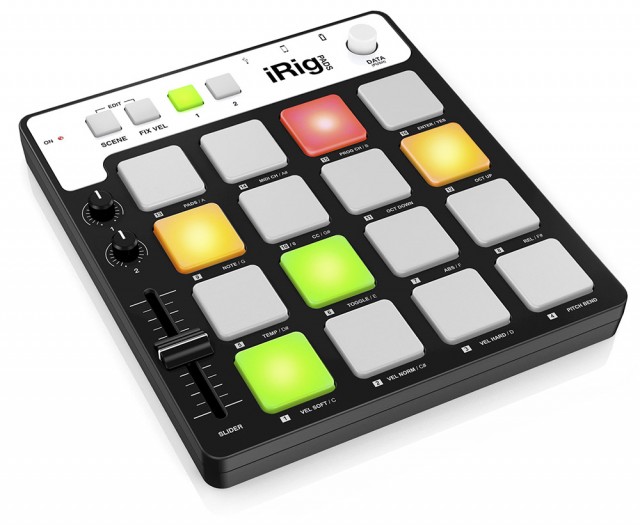
At the 2014 Winter NAMM Show, we spied the unannounced iRig Pads at the IK Multimedia booth.
Now, IK is shipping the iRig Pads – a portable MPC-inspired MIDI pad controller for iOS, Mac & Windows. They say it’s the smallest ‘groove controller’ on the market – so it will fit anywhere you can store an iPad, in a backpack or a laptop bag.
Can IK’s inexpensive pad controller deliver on the promise of being portable, powerful and compatible?
The IK Multimedia iRig Pads
As their official intro video, above, shows, IK positions the iRig Pads as a portable pad controller that will work with just about anything.
The iRig Pads is a low energy consumption device – it draws its power directly from its host. So it doesn’t need the usual wall-wart for power.
It can be used with iPhone, iPad and iPod touch, via the included Lightning cable (30-pin connector sold separately), without the need of a Camera Connector Kit. It can also be used with Mac and PC, using an included USB cable.
It even comes with software to get started on each of the platforms.
Key Features:
- MIDI pad controller for iPhone, iPad and iPod touch, Mac and PC
- Portable & bus-powered
- 16-velocity-sensitive backlit rubber pads that light multiple colors, depending on velocity and outgoing and incoming MIDI messages
- Two MIDI knobs, two pushbuttons, one slider and a pushbutton rotary encoder, all programmable
- 16 user-programmable MIDI scenes for instant recall of custom MIDI maps
- Fully MIDI class-compliant
- Lightning connector and USB cable included, 30-pin cable available separately
- Expression/sustain pedal input
- USB port can supply power when connected to iOS devices for no battery drain
Getting Started
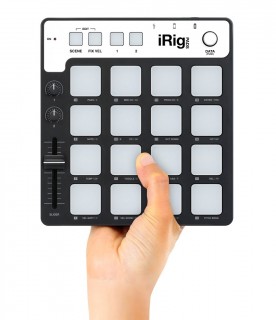 The iRig Pads is small, about the size of an outstretched hand. It’s lightweight too, but the case feels solid and sturdy.
The iRig Pads is small, about the size of an outstretched hand. It’s lightweight too, but the case feels solid and sturdy.
The face of the iRig Pads is dominated by a 4×4 pad grid – clearly MPC-inspired. The pads have a good feel – firm, with a little give – and are dynamic and sensitive.
Along the top, the iRig Pads also offers four button controls and a push-button rotary encoder. Two of the buttons are assigned to Scene and a Fixed Velocity toggle. The second pair of buttons is assignable.
Here’s an overview of the available controls:
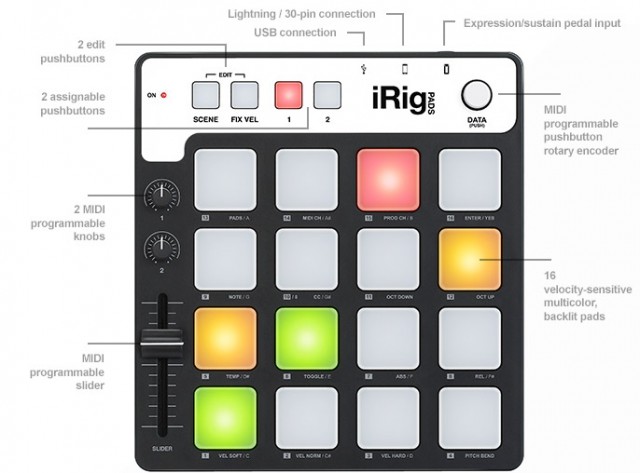
The weakest point of the iRIg Pads hardware is probably the slider. It does the job just fine, but doesn’t feel as substantial as the pad controls.
Along the top edge, the iRIg Pads has connectors for a USB cable, Lighting/30-pin iOS device cables and a 1/4″ expression or sustain pedal.
Two cables are provided:
- A USB cable for connecting the iRig Pads to your Mac or Windows computer; and
- A Lighting cable for connecting it to any current iOS device.
If you want to use the iRig Pads with an older 30-pin iOS device, you can, but you will need to buy an optional 30-pin cable.
Getting Started
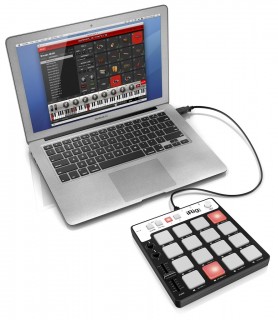 Getting started with the iRig Pads is straightforward. It’s just a matter of plugging it in and opening a compatible app.
Getting started with the iRig Pads is straightforward. It’s just a matter of plugging it in and opening a compatible app.
A brief quick-start guide is provided in the box, but no printed manual. In-depth documentation is available as a PDF download. We would have liked a printed manual, but providing it as a PDF is a reasonable way to keep costs down and minimize waste.
IK provides several apps to get you started.
- On iOS, SampleTank free, GrooveMaker 2 free and DJ Rig free.
- On Mac/PC, SampleTank 3 SE is provided as both a standalone and a plug-in virtual instrument for using in your DAW. It includes over 6.5 GB of sample contents, 400 instruments and 150 MIDI patterns. Registered iRig Pads users also get The Grid, a collection of 50 SampleTank instruments and 50 MIDI patterns.
Download links:
- The SampleTank Free App is available from the App Store on iPhone, iPad and iPod touch
- The SampleTank App is available from the App Store on iPhone, iPad and iPod touch
- The GrooveMaker 2 Free App is available from the App Store on iPhone, iPad and iPod touch
- The DJ Rig Free App is available from the App Store on iPhone, iPad and iPod touch
iRig Pads comes with a collection of pre-programmed ‘scenes’, for popular apps. To select a scene, you push the ‘Scene’ button and then use the pad grid to select from the available scenes.
Compatible With Any MIDI App
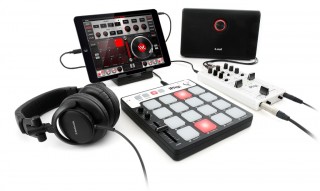 In addition to the IK apps, you should be able to use iRig Pads with any MIDI-compatible app:
In addition to the IK apps, you should be able to use iRig Pads with any MIDI-compatible app:
- iRig Pads is fully MIDI class-compliant. You can use it with MIDI-compatible iOS apps (including FL Studio Mobile, iMPC Studio and GarageBand) and Mac/PC software (including MPC Studio, Ableton Live, Maschine, GarageBand, etc)
- All controls are customizable. You can create up to 16 MIDI scenes, assigning any MIDI note or CC to the controls.
iRig Pads is a natural fit for use with beatmaking apps and drum machines. But it’s equally interesting as an alternative controller for other MIDI apps.
Using iRig Pads with synth apps opens up new performance options, because it encourages you to explore sounds in different ways. Just as MIDI wind controllers open up lyrical performance options with software synth, the iRig Pads are ideal for exploring the percussive and rhythmic potential of sounds.
Summary
IK Multimedia’s iRig Pads is a flexible and fun MIDI controller for working with beatmaking apps and other MIDI-compatible apps.
Paired with an iPhone or an iPad, it makes an extremely portable MIDI music making setup. And, in the studio, it works equally well with your Mac or Windows apps.
With a street price of about $150, the iRig Pads offers a lot of bang for the buck.
Pros
- Plug and play
- Cables included for iOS, Mac & Windows (30-pin available as an option)
- Solid build quality & good ‘feel’ on the pads
- Fully MIDI class-compliant
- Bus-powered
Cons
- Limited app mappings
- List of official ‘partner apps’ is fairly small
- No printed manual
iRig Pads Official Demo Videos
Pricing and Availability
iRig Pads is now available for US $149.99/€119.99. See the IK Multimedia site for more info.
If you’ve used the iRig Pads, leave a comment and let us know what you think of it!

whats different to a mpd16? besides the leds…
A couple of knobs and a bit more compact.
it works with ipads + iphones, which the mpd’s will not.
I think it’s the only decent pad controller right now that works with both iOS and Mac/PC.
I looked at the Korg PadKontrol, too, but it’s not low-power and can’t connect directly to an iPad. So you’d have to carry around a wal-wart and a CCK adapter.
MPD16 has an actual MIDI port, so you don’t need to use it with a computer to control your hardware.
I still think of that as ‘real’ MIDI.
I’ve had this awhile and really like it. I use it with my Mac. I could use it with my iPhone but frankly I just don’t see the point of IOS music. I suppose it’s nice to think it *can* be used that way but the thing I’m interested in is how to use it with a 5 pin DIN module. Now I can do this via the USB running into my Mac then out to a USB to DIN converter. I’d like to be able to do this without the computer. As well as this USB connection it comes with what IK describe as a mini DIN plug and a cable to connect this to a lightning connector (supplied). I’m wondering if a cable could be available to connect to an old-style 5 pin DIN plug? That would make me very happy.
This may be more than what you are looking for, but I’d highly recommend the iConnectivity MIDI interfaces. They let you connect just about any MIDI device – iOS, Mac, PC, software, hardware, USB, DIN whatever.
Yes I looked at the iConnectivity products. As always, the devil is in the details! I’m not sure these work without a computer – anyway I’m trying to have a simplified solution. It seems to me that if you can interface a midi pad controller to a lightning connector, then the same port should be able to work with an old style 5pin DIN MIDI connector? just need the right cable. The trouble is it’s hard to find I/O connection data (specially Apple) these days.
I’ve been using it with an iPad as my main MIDI controller and it works great.
It’s way more portable than keyboard controllers and it’s a good fit for the types of things I want to do with a mobile setup – jamming and beatmaking.
IK is also one of the only companies that makes it easy to connect to mobile devices – they just give you the cable you need. Why can’t other companies get this right?
Has anyone gotten this thing to work with the pads section on beatmaker 2? For me it will only trigger sounds in the keyboard section. I searched the internet far and wide but can’t find how to get it working on the pads. Could anyone help please?
There are built-in scenes, but it doesn’t appear that those are going to work instantly out of the box with your app. You do have the ability to create your own scenes which will probably help and you can see that some users are using this feature (even though the post is about the built-in scenes and which apps they work with, there is some good discussion too) at this IK forum post http://cgi.ikmultimedia.com/ikforum/viewtopic.php?f=18&t=9040
Thanks for the response but that’s not detailed enough for me. How do i even go about creating a scene? What’s the first step? Thanks.
Thanks for responding to reader questions!
Some readers would like to know more about what’s involved in making custom scenes – is the editor manual PDF available outside the registered area of your site so that they could check it out?
has this thing midi in ?
Yes. At least via USB (which is what I use). Apparently you can drive the lights via midi. I’m not sure what use that is. The IOS apps seem to take control of the unit. I don’t like that, but then I don’t wear a baseball cap backwards either
You’re a pitcher, not a catcher.
Does anyone have any ideas about how to get it to work with the pads screen in beatmaker 2? Again, it works with triggring sounds from the keyboard screen, but not the pads. I’ve tried contacting intua as well as ik multimedia. No response from either, so i figured i’d look for help around here. Thanks in advance.
Hi, see my reply above and please let me know what your ticket number is so I can ask the support team about your inquiry. You can also check out our official forum at http://www.ikmultimedia.com/forum (including the link to the thread posted in my other reply) and if you don’t have a ticket number just contact one of the moderators there with the contact information you used to submit your request to IK (and details about how you submitted it). Thank you.
Your forum is janky. I push submit over and over and the screen just refreshes without having submitted. I’ve tried several times over the past few days. It boggles my mind why your mpc-style controller wouldn’t have a scene for beatmaker 2, by far the most advanced mpc-style app.
anyone using this with the impc pro, if so how did you set it up?
My 2p; don’t buy and get a Quneo instead
My 2 cents – the QuNeo is a great controller, but the feel is nothing like an MPC, which this covers nicely. Also, the editor for this is easier to use! The QuNeo is a little lighter, though, and offers more controls.
I don’t think we can begin to strike points on this over the Quneo – for the money this iRig controller is smashed. On top of the array of extra controllers and scenes, then velocity, pressure and X-Y response, and also the build quality of the Queno it also has an emulation mode for that Maschine, Akai, and Korg feel. If you are wanting to cripple the controller to a switch based device feel you can go that way – “All other drum pads have a mechanical switch that does a one-time detection of when the pad is hit, so the feel of the pad is largely determined by the type of switch and where it is located,” explained Keith McMillen, president and founder of KMI. “QuNeo continuously senses the varying pressure and location of the player’s gestures, so we can acquire the displacement, velocity and acceleration data of the hit to generate pretty much any response and feel.”
Which is useful for some, but useless if you want an MPC style controller.
The QuNeo doesn’t have that feel, and though it is built tough, it still feel lightweight.
I agree in that sense, but then we are just talking about a subjective experience that is personal to each player, some people will want a MPC feel and many more will what it to feel different – like comparing a player liking a ‘synth action keybed with aftertouch’ to a ‘fully-weighted velocity only keybed’. I can’t see any real winning or losing over the feel of the device as it will always be a plus to some and a disadvantage to many more. What we are talking about here is replicating a mechanical response of technology from a lesser knowledgeable time, I can see why that would suit some people.
I have a Quneo, are you guys saying that the quneo with all of it’s talents can feel like anything ….BUT the mpc?
I don’t see the point, why not use a touch screen? I wish Irig would pay more attention to quality audio ins and outs at cheap prices.
Garak – if using a touch screen meets your needs, then an external MIDI controller isn’t for you. This really is tailored to people that want velocity sensitive control or just a more tactile controller.
so is anybody using this with the impc pro ????
Works fine – it comes with scenes for it.
The only disappointment is that you still end up using the touchscreen for a lot of things. But for the price , you can’t expect it to be Maschine.
No one cares about impc pro. It’s a huge failure.
Tons of users, lots of sharing on Soundcloud, just not your cup of tea.
thanks Fester, as long as it has all the pad banks, good enough i guess.